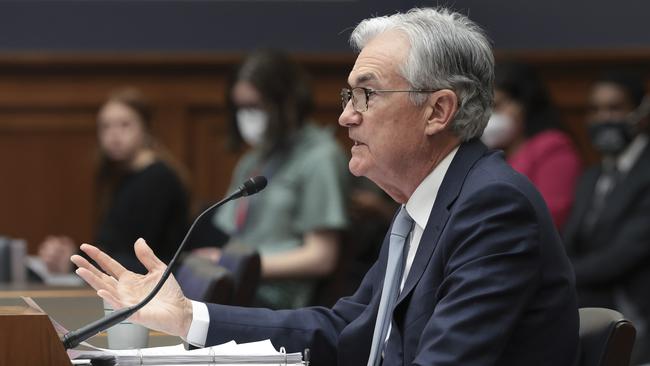Powell plans to seek quarter-percentage point rate increase
Federal Reserve Chairman Jerome Powell says he will propose a 25 basis-point US interest rate increase this month, easing market fears of a more aggressive stance to combat inflation.

Federal Reserve Chairman Jerome Powell said he would propose a quarter-percentage point rate increase in the central bank’s meeting in two weeks amid high inflation, strong economic demand and a tight labour market.
Before Russia’s invasion of Ukraine, Mr Powell said he expected the central bank to continue a series of rate increases this year. While he said it was too soon to say how the war and the strict economic curbs imposed by the West against Moscow would influence the US economy, he hinted at growing urgency to continue to tighten monetary policy.
“For now, I would say that we will proceed carefully along the lines of that plan,” Mr Powell told the House Financial Services Committee on Wednesday. “We’re going to avoid adding uncertainty to what is already an extraordinarily challenging, uncertain moment.” Mr Powell said he expected the central bank would also make good progress preparing its plans to shrink its $US9 trillion asset portfolio but that it wouldn’t finalise them at the March 15-16 meeting.
Most Fed officials have indicated they would prefer to begin raising their benchmark rate in March by a quarter percentage point – the size of all Fed rate increases since their last half-point move in 2000. A few officials have hinted over the past week that they would be open to a larger increase this month.
Mr Powell began to lay the groundwork Wednesday for the possibility of larger-than-anticipated increases this summer – by half-percentage-point increments – if inflation doesn’t diminish soon enough.
Mr Powell and his colleagues “have an expectation that inflation will peak and begin to come down this year,” he said. “To the extent inflation comes in higher or is more persistently high than that, then we would be prepared to move more aggressively” by raising rates by a half percentage point at one or more meetings later this year.
His remarks underscore the challenge facing the central bank as it prepares to raise interest rates for the first time since 2018. Russia’s invasion of Ukraine, which prompted the West to impose harsh financial sanctions against Moscow this week, threatens to worsen inflation pressures by disrupting supply chains and pushing up energy and commodity prices.
“The near-term effects on the U.S. economy of the invasion of Ukraine, the ongoing war, the sanctions, and of events to come, remain highly uncertain,” said Mr Powell.
During geopolitical shocks, the Fed generally avoids taking steps that increase uncertainty. But with inflation running far above its 2 per cent target and the Ukrainian crisis threatening to push prices even higher, the Fed could feel more pressure to raise rates.
Mr Powell and his colleagues had anticipated US inflation, now running at a 40-year-high, to peak this quarter.
Consumer prices in January rose 6.1 per cent from a year earlier, according to the Fed’s preferred gauge. Excluding volatile food and energy categories, so-called core inflation rose 5.2 per cent, close to a 40-year high.
Fed officials last spring and summer attributed most of the rise in inflation to supply-chain bottlenecks, which wouldn’t necessarily demand a policy response if those kinks were expected to resolve themselves. But in his testimony Wednesday, Mr Powell suggested inflation was high because “demand is strong, and bottlenecks and supply constraints are limiting how quickly production can respond.” The emphasis on demand is important because Fed interest-rate increases can reduce demand by slowing down hiring and economic activity more broadly.
Mr Powell said he expected inflation to decline over the year as supply constraints ease and demand moderates due to tighter monetary policy and waning effects of fiscal stimulus from the past two years.
“But we are attentive to the risks of potential further upward pressure on inflation expectations and inflation itself from a number of factors, ” he said. “We will use our policy tools as appropriate to prevent higher inflation from becoming entrenched.” Mr Powell characterised the labour market as “extremely tight” and said the types of broadbased employment gains the Fed sought last year as it maintained aggressive stimulus policies are “only possible in an environment of price stability.” The global economy has been recovering from a series of “supply shocks,” in which shortages of goods or services drive up their prices. Textbooks call for central banks not to react to one-off increases in prices that result from temporary factors, such as natural disasters, and to instead focus on broader underlying inflation pressures.
But this could be tricky for the Fed right now because US inflation is already high. Officials are turning anxious about an overheated labour market with wage gains well above their pre-pandemic highs and the risk that consumers and businesses will expect bigger price increases in the future, fostering persistently higher inflation.
The Wall Street Journal



To join the conversation, please log in. Don't have an account? Register
Join the conversation, you are commenting as Logout